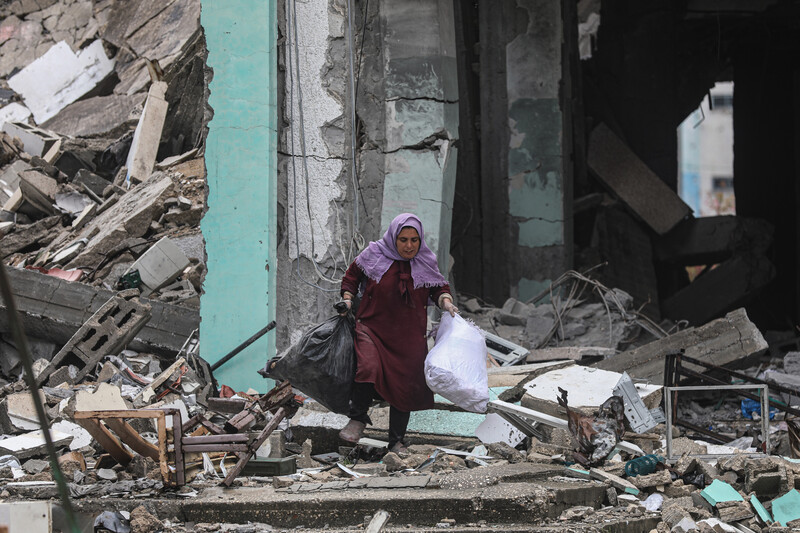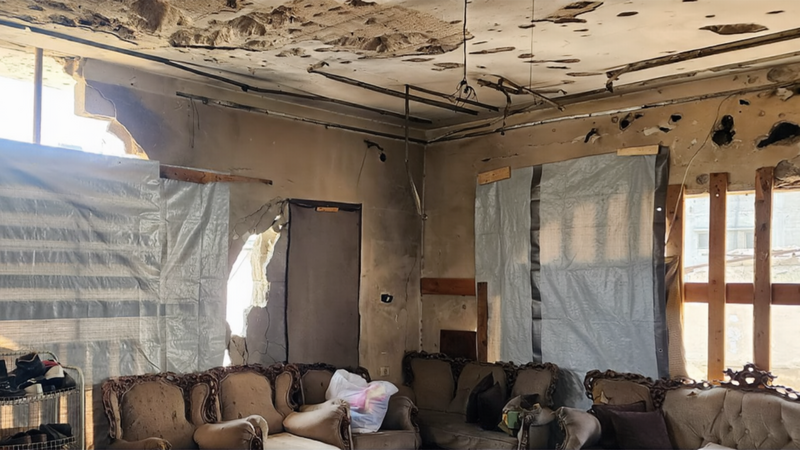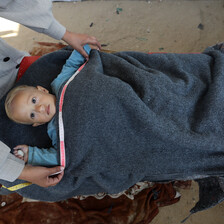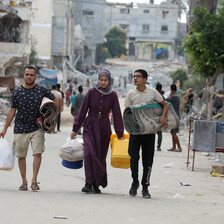The Electronic Intifada 23 April 2025

A woman clears debris from a destroyed house in Gaza City on 21 March 2025.
APA imagesIn the brief interlude between Israel’s genocide in Gaza part I and Israel’s genocide in Gaza part II, I managed to make my way back to my grandparents’ house in northern Gaza.
I had been living on my own for months. My mother and sister had left for Egypt in April 2024 on a medical permit for my father, whose condition had led to him securing a permit for all of us to leave.
But Israel’s ground offensive on Rafah in the south in May put an end to those plans. My father died in the tent we had been displaced to al-Mawasi in August.
Since then I was alone. I had no one. And every day in that tent felt like I was sitting in the open, no walls, no roof, no safety … just fear.
On the night when it was announced that the ceasefire would happen, a huge storm hit Gaza. My tent was shaking, and I felt scared. I called my grandmother, Khitam, and she told me to come with them back to their home in the al-Daraj neighborhood of northern Gaza City, even though we knew it had been damaged in Israel’s bombings.
The journey was incredibly hard. My grandmother is in a wheelchair, and pushing her through the mud and sand from the rain the night before proved nearly impossible.
But with my grandfather’s help, we managed.
My grandfather, Issam, is 67. He is a kind, funny and loving man who always talks about the value of education and the importance of our land. He kept a small garden behind his house where he grew vegetables, mint and basil. I used to love picking fresh basil to make pesto sauce for spaghetti – one of my favorite meals.
The garden is long gone now.
Cleanup
When we arrived my heart sank.
The house was nearly destroyed.
There was dust everywhere, debris in every corner, and the wall facing the street had collapsed, as if the world itself had cracked open.
It wasn’t a home. It was the ghost of a memory.
I stood in silence, staring at the ruins.
I had no money. No relatives to help. My uncles were all in tents near their homes in Tel al-Hawa, a neighborhood in southern Gaza City.
But I told myself, “If not me, then who?”
So I started.
I swept the floor, cleared out the rubble, removed the broken wood and stone. Every movement was a battle, and it was exhausting work.
The biggest problem was the missing wall. The cold wind met no resistance, piercing us like knives. Dust was impossible to keep out. We were exposed, vulnerable, freezing.
I thought about having someone rebuild the wall with bricks or cement blocks, but the cost was prohibitive, at more than $100.
Even plastic tarps were too expensive when you added in the labor.
All I wanted was a barrier between us and the elements.
Lessons for nylon
A few days after we arrived at the house, my grandfather was on the phone with an old friend. During the conversation, he found out that the man’s son installs makeshift nylon sheet walls.
My grandfather spoke with him, and by some miracle, he agreed to help. He did not ask for money. Instead, he wanted to know if I would teach his daughters, Razan and Zein, English for three months.
I immediately said yes, tears in my eyes. Not just because the problem was solved, but because I finally felt like I had something to offer.
I wasn’t just a burden. I could give something back.
They installed the nylon wall. It wasn’t bricks or stone, but it was something. It shielded us from the street, from the wind, from the eyes of strangers.

It’s not bricks or stone, but it shields us from the street, from the wind and from the eyes of strangers.
And in that fragile sheet, I found strength, and I threw myself into teaching the two girls.
We sat in what remained of the house, under flickering lights and crumbling corners.
Razan loved learning new words. Zein was cheeky, always mispronouncing things and laughing at herself.
For the first time in months, I laughed too.
But at night, when the wind howled and made the nylon tremble, I was reminded of how fragile our situation was.
Nevertheless, I woke up each day and kept going. Cleaning. Teaching. Surviving.
VIsitors
Then, during Ramadan, people started visiting us.
Neighbors. Friends. Strangers who had heard about us.
They walked in, saw the nylon wall and how we had organized our space with so little. They spoke to my grandfather and said: “Brilliant idea!”
“She’s amazing.”
“We should’ve done this ourselves!”
I listened in silence, my heart swelling – not from pride but from gratitude.
They saw us. They understood our struggle. They found hope in what we had created.
Soon, some visitors brought food. Some came to break fast with us. Others brought bread or just warm, kind words.
And every night, I looked up at the roof above me – fragile as it was – and whispered: Alhamdulillah.
Thank God for this mercy.
Thank God that people still have hearts.
Maybe life broke me once – but it didn’t erase me.
This wall, made of nylon, became a witness to resilience and to the kindness of people who still stand with each other.
Genocide part II
One night, a rocket landed so close to us that shrapnel tore through the air around us.
No one was hurt. But we had to move again.
We were displaced for 10 days before we could return. But our short, illusory moment of safety had gone.
Food is scarce again. The bombing is as savage as ever.
Perhaps it is harder now than during the first part of Israel’s unhinged aggression. This time we know what to expect: No food. No medicine. No safe shelter.
Just a bitter truth: that we and our children will go hungry, will get sick and will freeze – and no one will shield us.
But that fragile nylon wall, trembling with every gust of wind, still survives – just like us.
Lina Hamdona is a writer and pharmacy student from Gaza.





